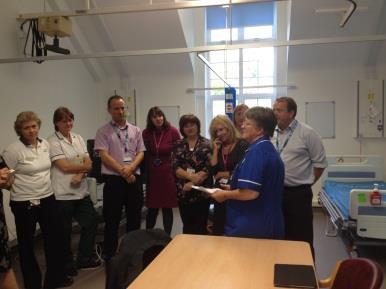Faced with a growing older population, one struggling health economy created a strategy and a no blame culture to improve their services. Jonathan Inglesfield and Joe McEvoy explain how
How does a fledgling clinical commissioning group grasp the challenge of the better care fund, transform hospital length of stay and fire up the imagination of the local health and social care community?
Early last year, the executive team at Guildford and Waverley CCG faced the unenviable challenges of significant excess bed days in its acute hospital; a new community service provider that had not yet comfortably “bedded in” with its GP partners; and a sizeable quality, innovation, productivity and prevention challenge to balance the in-year budget.
‘Two-thirds of our frail elderly inpatients could be cared for outside of an acute hospital had an alternative existed’
Guildford and Waverley is a medium sized CCG with a population of 240,000. It has one main acute hospital (The Royal Surrey County Foundation Trust), three community hospitals and a network of 21 high quality GP practices. Virgin Care provides community services and is working hard to improve productivity through service transformation.
At any one time two-thirds of its frail elderly inpatients could be cared for outside an acute hospital, and 20 per cent could have been admitted to an alternative facility, had alternatives existed at the front door. Those were the stark conclusions of a previous audit, with little systemic change having been made since.
- A fragmented system can’t deliver whole person care
- Start a conversation with NHS staff and patients to drive change
High expectations
Patient engagement and stakeholder events had confirmed the community’s expectations of its health facilities were high.
The Save the Royal Surrey campaign had highlighted the imperative to maintain a fully functional hospital, which has dual district general hospital and tertiary cancer functions.
The facilities had a pivotal role in the villages and towns, and there was a desire to see these grow and redevelop, rather than wither away. There are two active borough councils that prioritise health issues, and a large and efficient county council as the commissioner of social care. GP practices are supported by a large number of active patient participation groups, with some of these independently raising funds and hosting packed events in village halls to highlight health issues. The CCG has social capital in spades.
‘There were no savings to be made in our locality through quick closures of disused or unloved facilities’
There were no savings to be made in the locality through quick closures of disused or unloved facilities.
Yet with such social capital and a textbook portfolio of health facilities, why was the CCG struggling with length of stay issues, and why did the health economy feel under such threat?

Population challenges
The answer was simple: demographics. Our health dashboard shows above average health experience for every disease area except malignant melanoma and road traffic accidents, and our life expectancy as a locality is higher than the national average: 84.9-years-old for women versus 82.8 for men.
‘It was clear we needed a health community-wide approach’
We have more than 70 care homes, mostly in rural Waverley Borough - a typically attractive place for a “home counties” retirement.
Quite simply, our ageing population meant our emergency admissions for the frail and elderly were steadily increasing, and at presentation to the hospital, our patients were sicker and more complex than ever. It was clear we needed a health community-wide approach, and we began with two distinct areas.
Primary care approach
The first was primary care. We took advantage of the opportunity of both the unplanned care enhanced service for GPs and the £5 investment - part of the government drive to invest £5 per head in frailty services - initiative for elderly services to redefine the work streams of primary care. Using these resources in parallel, we coined the expression “the fourth work stream” - this being the interest a GP has in their inpatients, and those who are at risk of admission or who have just been discharged.
‘The response was comprehensive and the bids imaginative and locally tailored’
Essentially, the fourth work stream is “frailty”. This needed clearly defining and firewalling from the other responsibilities of primary care, otherwise the remaining three work streams - routine appointments, practice administration and home visiting - would consume all the resources critically needed to support the elderly.
Practices were invited to submit individual bids explaining how they would achieve this, and go much beyond the limited requirements of the unplanned care directed enhanced service.
The response was comprehensive and the bids imaginative and locally tailored. Virgin Care rose to the challenge, offering to match the GPs’ efforts with community nursing support to ensure the package was complete.
The funding awarded under the scheme was primarily used by practices to appoint care coordinators and additional clinical time to deliver fourth work stream activity in a way that would not have been possible solely using the recycled funds from the unplanned care directed enhanced service.
Grasping length of stay
Second, we needed to understand the length of stay issues. This needed a multi-agency approach. Existing better care fund meetings were held at the CCG offices, but it was obvious we needed a change.
We moved venue to the hospital and designed the meetings as dual administrative and clinical ones. We needed to be walking the wards to understand the issues. The group was named the “hospital implementation group of the BCF” because it aimed to link need to evidence of the impact that the better care fund has on the hospital.
‘The open culture encouraged drop-in from visitors including both CCG and acute hospital chief executives’
Attendance at the hospital implementation group was impressive. Senior managerial leads from social care, the acute and community providers, the NHS Continuing Healthcare provider (or CHC) and the CCG were joined by an enthusiastic group of clinicians from community and hospital therapy and nursing services, as well as medical directorship attendance from both the provider and commissioner sides.
No blame culture
The open culture encouraged drop-in from visitors including both CCG and acute hospital chief executives. We rapidly laid bare the issues, pushing a “no blame” culture. We looked at the data, length of stay and community rehabilitation services activity, but it was anchored by what is best for the patient. After six months of considerable progress, culminating in the powerful implementation of our local interpretation of the “perfect week” which allowed us to close 28 beds and maintain a net position of 35 empty beds for the following six weeks, we then took the group “on tour”.

It was counterintuitive to stay entirely within the hospital when we knew the solutions were health system-wide. So we started by hosting the meetings within our community hospital sites and GP surgeries.
This took a little getting used to at first; the obvious question from our community hosts was “why does the hospital implementation group want to meet here?” At the first meeting, a simple question was asked: have you all met? The teams had not, but rapidly the GP practice management team, GP clinical lead and frailty administrator were exchanging ideas on closer working with the hospital discharge coordinator and therapy leads, and the fourth work stream sprang into life.
At the community sites we learnt that, away from an acute hospital setting, there was a different pace of working. Partly tradition, and partly thrust upon the sites by other agencies that held a “non-urgent” view of their work, natural delays in CHC assessments and social care packages appeared.
‘The teams had not met but were rapidly exchanging ideas on closer working’
However, you cannot functionally separate the acute hospital from its community “step-down” sibling. They are a continuum in the care pathway and need to be managed in the same manner, are as efficient as the acute hospital, and are assisted with the same level of urgency by external agencies.
To combat delays in the CHC process, we identified additional resources to optimise the service, also promoting the ethos of “discharge to assess”, mindful that all rehabilitation goals are unlikely to be comprehensively achieved as an inpatient.
For delays in social care assessments, we worked with social care, as core members of the group. We set expectations of high efficiency for all our clinical sites.
There were multiple teams offering overlapping functions, often from different providers. We encouraged the development of an integrated discharge team, now being developed with dedicated support.
For complex health and social situations, on more than one occasion we elected, in association with social care, to “fund without prejudice”, pending later assessment to facilitate a discharge.
There were problems with equipment provision in the community as a delay to discharge; we labelled this a “never event” - something we should never see as a block to discharge.
The journey has been fascinating, and indeed, fun for those involved. It remains a work in progress, but we firmly believe our innovation has laid the foundations for true transformation in our frail elderly services.
The early results of the work are promising, as highlighted in the data set. The unscheduled length of stay in over 65s has dropped by a day over the last year, at a time when many systems are seeing a rise.
Dr Jonathan Inglesfield is a medical director and Joe McEvoy is director of clinical commissioning, both for Guildford and Waverley CCG



























No comments yet